Did you know you can do calisthenics exercises without any equipment? This makes them great for both beginners and seasoned athletes. You don’t need to spend money on gym memberships or fancy gear1.
Calisthenics uses your body weight for strength training. It’s different because it’s flexible and helps you get stronger by doing everyday movements. Our beginner plan guides you through workouts for six weeks, helping you get better each week.
Starting with calisthenics can be both thrilling and a bit scary. Our beginner calisthenics workout plan shows you how to begin. It’s packed with benefits and tips to keep you motivated on your fitness journey.
Key Takeaways
- Calisthenics workouts require no special equipment—just your body weight.
- Performing calisthenics exercises can improve functional strength and body control.
- Our beginner plan includes a six-week structured program with multiple weekly workouts.
- Calisthenics training can increase muscle mass and size through high-volume exercises1.
- Warm-up routines and stretching exercises are essential parts of this calisthenics workout plan beginner.
What is Calisthenics?
Calisthenics are bodyweight exercises that boost strength, flexibility, and endurance. They follow the CDC’s guidelines for exercise, which only 21.7% of adults meet2. Let’s explore what calisthenics is and why it’s great for beginners.
Definition of Calisthenics
Calisthenics for beginners are simple, rhythmic movements done anywhere without special gear. They have ancient Greek roots and became popular again in the 19th century3. A beginner’s routine might include push-ups, squats, and pull-ups. Calisthenics is perfect for newbies because it’s easy to start and grow with.
Benefits of Calisthenics for Beginners
Calisthenics offers many benefits for beginners. It combines aerobic and anaerobic workouts for heart health and muscle strength2. A beginner’s routine might include push-ups, squats, and jumping jacks. For example, doing 20 push-ups can strengthen your upper body, while 50 crunches target your abs3.
Calisthenics also boosts leg strength and cardio with 25 jump squats3. It’s a budget-friendly option since you don’t need any special equipment. You can do it at home or in a park, making it easy to fit into your day. Plus, it’s fun and keeps you motivated.
For a detailed guide on starting calisthenics, check out this beginner’s calisthenics workout plan2. If you’re also focusing on weight loss, this resource on weight loss warnings is helpful3.
Setting Up Your Calisthenics Workout Environment
Creating the perfect environment for your calisthenics workout is key to success. Knowing the essential equipment and choosing the right space is important. This helps you follow a calisthenics beginners guide effectively and enjoy your workouts.
Essential Equipment for Home Workouts
You don’t need much to start your calisthenics routine. Basic items include a pull-up bar, gymnastic rings, and a good yoga mat. A pull-up bar is great for upper body exercises and can be hung in a doorway. Gymnastic rings are versatile and adjustable for various exercises. A yoga mat keeps you comfortable and safe during floor exercises like push-ups and planks.
Resistance bands are also useful for adding variety and intensity. They let you focus on bodyweight exercises, which are perfect for beginners. These exercises are easy to do and don’t require a lot of skill4.
Choosing the Right Space for Your Routine
Pick a clean, spacious area for your workout. It should be free from obstacles. Whether indoors or outdoors, safety is crucial. Indoors, choose a room with enough space and good air flow.
Outdoor spaces like parks or backyards are great for calisthenics. Make sure the ground is even to avoid injuries. The right space keeps you safe and motivated to follow your calisthenics guide.
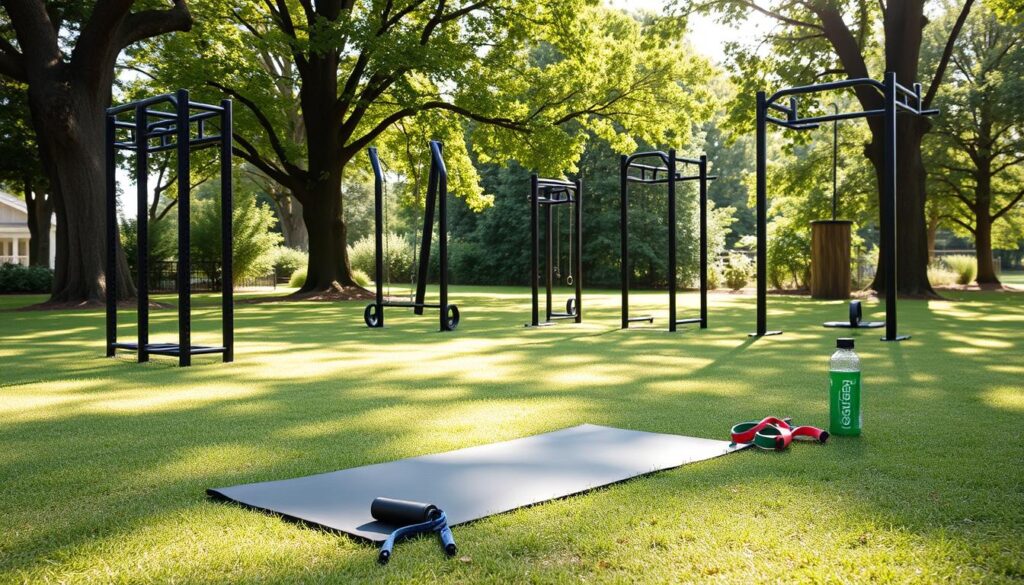
| Equipment | Benefits |
|---|---|
| Pull-up Bar | Essential for upper body strength exercises |
| Gymnastic Rings | Versatile and adjustable for different exercises |
| Yoga Mat | Provides comfort and safety for ground-based workouts |
| Resistance Bands | Adds variety and intensity to workouts |
Setting up your workout space thoughtfully boosts your chances of reaching your fitness goals. Calisthenics doesn’t need a big gym or expensive equipment. The right choices make your workouts productive and enjoyable.
Warm-Up Routine for Calisthenics Beginners
Starting a calisthenics program is exciting but needs a good warm-up to avoid injuries and boost performance. A proper warm-up gets your heart rate up, makes muscles more flexible, and improves your workout. Dynamic stretching is especially good because it lowers injury risk and increases flexibility.
Importance of Warm-Ups
Warm-ups are key for calisthenics program for newbies because they offer many benefits. Studies show dynamic stretching helps with flexibility and cuts down injury risk during workouts5. Spend 5-10 minutes on these stretches before your workout to better control your muscles and move more freely5. Also, skipping static stretches during warm-ups can reduce injury risk by 30%, making dynamic stretches safer6.
Sample Warm-Up Exercises
A good warm-up routine is vital for beginners in calisthenics program for newbies. Here are some great exercises for beginners:
- Cardiovascular Warm-Up: Begin with light cardio like jumping jacks or jogging in place to raise your heart rate.
- Shoulder Dislocates and Rotations: Do 10 reps each to improve shoulder flexibility and mobility6.
- Cat Camel: This exercise helps with thoracic spine mobility. Aim for 10 repetitions6.
- Wrist Rocks and Rotations: These are crucial for warming up your wrists, focusing on flexibility and mobility. Do each for 10 reps6.
- Scapula Push-Ups and Pulls: These exercises are great for scapula training, helping with shoulder joint stability. Do 5-10 reps each6.
- Dynamic Stretches: Include movements like Cossack squats and high knees to get your whole body ready for the workout7.
Each exercise targets different muscle groups, making sure your body is ready for the workout. Warming up not only prevents injuries but also boosts your workout performance. It’s a crucial part of any calisthenics program for newbies.
Core Calisthenics Exercises for Beginners
Starting with core exercises is key for beginners in calisthenics. Let’s explore the basic exercises that will help you begin your fitness journey.
Push-Ups: Proper Form and Variations
To do a push-up right, place your hands shoulder-width apart and align your body straight. Lower yourself until your chest almost touches the floor, then push back up. For newbies, try incline push-ups to ease the challenge by using a platform8. As you get better, add diamond push-ups to work your triceps more.
Squats: Techniques and Benefits
Squats are great for strengthening your lower body and improving balance. Stand with your feet apart, keep your back straight, and lower your hips down and back. Try Sumo Squats for extra focus on your glutes and thighs8. Regular squats boost your balance and stability, essential for beginners.
Pull-Ups: How to Get Started
Beginner pull-ups might seem tough, but they’re doable with practice. Use a pull-up bar and grip it with your palms facing away. Hang with your arms straight, then pull up until your chin clears the bar. For help, use resistance bands or start with negative pull-ups.
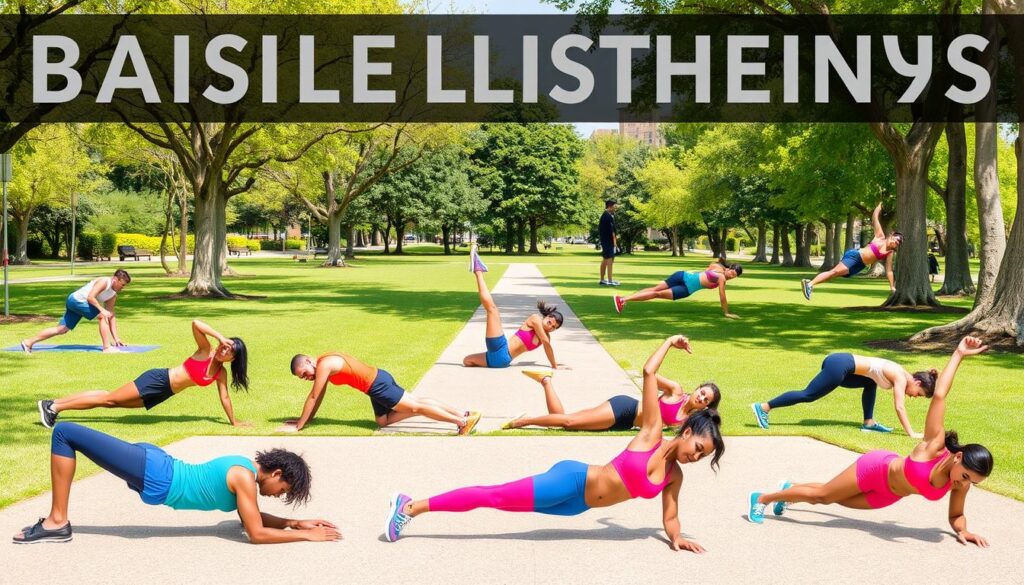
Calisthenics Workout Plan Beginner
This beginner calisthenics workout plan is here to help you start. It balances strength training and rest days. This balance lets your muscles recover and get stronger.
Monday: No Equipment Day
On Mondays, do bodyweight exercises without any equipment. This is perfect for home workouts or when you don’t have gym access. Try push-ups, squats, and lunges. Aim for 3 sets of 8-12 reps each9.
These exercises target big muscle groups well. They help build strength when done right10.
Tuesday: Basic Beginner Day
Tuesdays focus on simple, basic movements. Start with planks and superman holds for your core11. Use a superset of 10 to 1 to engage your muscles and build endurance11.
Wednesday: Rest Day
Wednesday is a rest day for muscle recovery. Listen to your body and rest when needed. This prevents overtraining and keeps your workout routine consistent11.
Thursday: On-The-Go Day
Thursdays are for quick, effective workouts anywhere. Do mountain climbers, side planks, and squats to work out different muscles10. These workouts last 30 to 40 minutes, fitting into a busy schedule10.
Friday: Fat Removal Day
Fridays focus on fat loss with high-intensity intervals. Do continuous circuit exercises like jumping jacks, burpees, and high knees. This keeps your heart rate up and burns calories10. It significantly boosts your fitness and helps lose fat11.
Saturday: Beginner HIIT Day
Saturdays are for High-Intensity Interval Training (HIIT). This advanced method boosts muscle growth and reduces overtraining risk, even for beginners9. Include push-ups, squats, and pull-ups, aiming for a proper stimulus-to-fatigue ratio9.
Sunday: Rest Day
Sunday is another rest day for muscle recovery. It follows the recommended rest days throughout the week. This ensures your muscles are well-rested for next week’s routine9.
Tracking Your Progress and Setting Goals
Tracking your progress and setting goals are key to staying on track. For beginners starting a calisthenics schedule, keeping a log is vital. It helps you see what you’ve achieved and what you need to work on.
How to Measure Your Success
Logging your workouts is a great way to measure success. Record the number of reps, sets, and how long each exercise takes. This shows you which areas to focus on next.
Also, watch for physical changes like getting stronger or more endurance. Adding compound movements to your routine can greatly improve your fitness and health12. Exercises like squats and push-ups are great for tracking strength gains4.
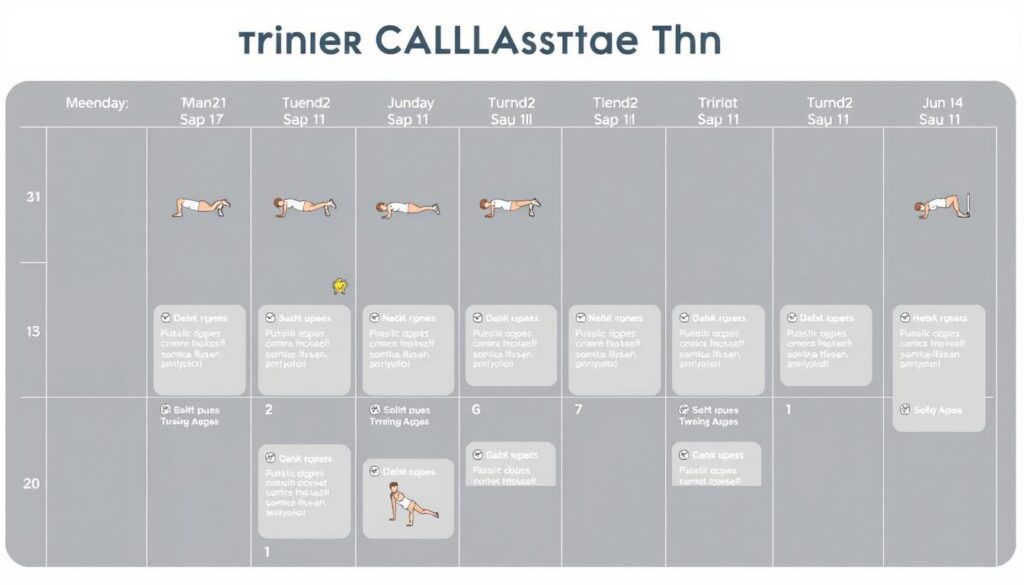
Setting Achievable Fitness Goals
Start by understanding your current fitness level to set goals. Aim for goals in areas like mobility, strength, endurance, and flexibility. Beginners should start with simple exercises and gradually get harder as they get stronger4.
This method helps avoid injuries and keeps you motivated as you see progress. Setting goals for fat loss, muscle gain, endurance, or aesthetics will shape your workout plan. Calisthenics can improve coordination and overall fitness13. For more on setting goals and tracking progress, check out this beginner’s guide.
Common Mistakes to Avoid When Starting Calisthenics
Starting your calisthenics journey? Watch out for common mistakes. Knowing these can help you stick to your workout plan and reach your fitness goals.
Overtraining and its Consequences
One big mistake is overtraining. It can stop you from getting stronger and might even hurt you14. Without rest, your performance can drop by up to 20%15.
Make sure to include rest days in your plan. This lets your muscles heal fully.
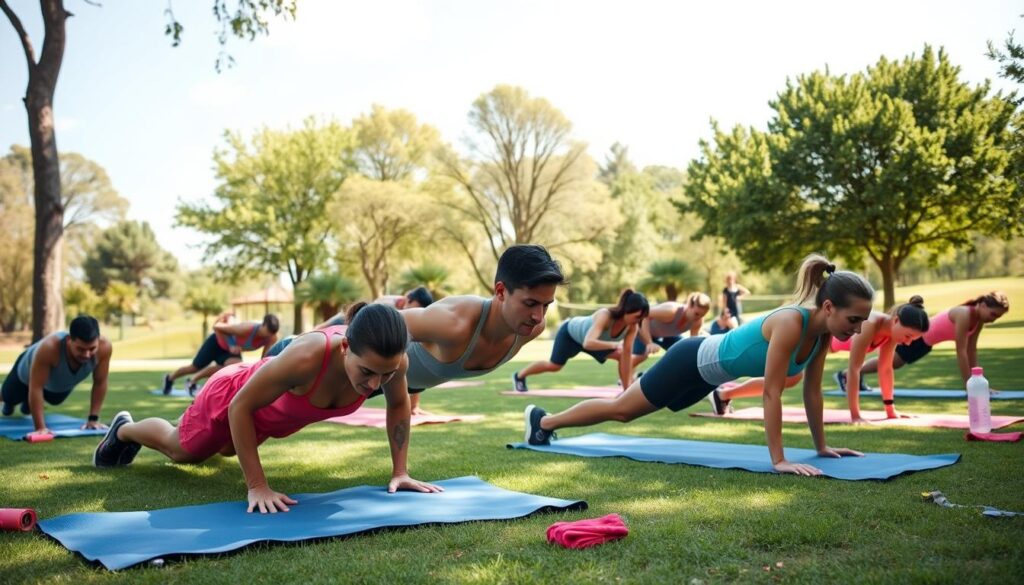
Incorrect Form and How to Correct It
Not doing exercises right is another mistake. It can make your workouts less effective by 25% and raise injury risks15. It’s key to focus on doing exercises correctly, not just how many you do14.
Seek help from trainers or online guides to fix your form. Warm-ups and cool-downs can cut injury risks by 30%15. Adding mobility exercises can also boost your range of motion by 15%15.
Don’t forget to add progressions to your workout plan. They make exercises easier and help you keep getting stronger. Skipping progressions can slow your gains by 40%15.
By avoiding these mistakes, you can make your calisthenics routine better. This ensures you keep improving and stay safe from injuries.
Tips for Staying Motivated in Your Calisthenics Journey
Staying motivated in your beginner calisthenics routine can be tough. But, a few key strategies can really help. Finding a workout buddy or joining online communities are great ways to keep the excitement going. These tips will help you stay enthusiastic and reach your fitness goals.
Finding a Workout Buddy
Working out with a friend is a great way to stay motivated. It adds a fun element and keeps you accountable. Plus, sharing your fitness journey with someone can make it more enjoyable.
Training with a buddy means you both learn and support each other. This leads to better results and progress in your calisthenics program.
Joining Online Calisthenics Communities
Online calisthenics communities are another great motivator. They let beginners share their experiences and get advice from pros. Social media and forums are full of support and inspiration to keep you on track.
Getting involved in fitness challenges can really motivate you. Mixing up your workouts keeps things interesting and prevents boredom. Seeing what others achieve can also inspire you to do better.
Remembering why you started is key. Keeping your goals in mind helps you stay focused. Visualizing your success can also give you a mental boost when things get tough.
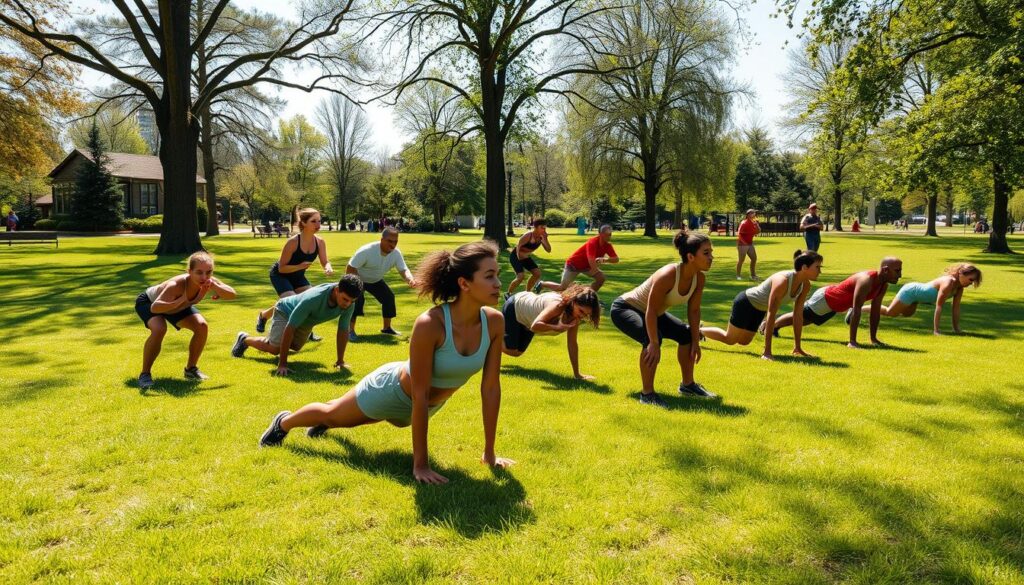
In summary, having a workout buddy and joining online communities are great for staying motivated. They offer support and new ideas to keep your fitness journey exciting. For more tips on living a balanced life, check out HealthyYogaTips for advice on fitness and wellness16.
Advanced Calisthenics Moves to Aim For
As you get better at calisthenics, you might want to try harder moves. These exercises make your workouts more interesting and boost your strength, balance, and coordination. Muscle-ups, handstands, and planche are top choices. They need hard work, the right technique, and regular practice to get right.
Muscle-ups are a mix of pull-ups and dips done smoothly. They work your upper body, like your back, shoulders, and arms. For muscle-ups, use fewer reps but higher intensity, and rest longer to see better results17. Focusing on upper body workouts can help you learn this move faster17.

Handstands are a big challenge in calisthenics. They need strength, balance, and focus. To get stronger in handstands, do at least 7 hard sets per week for each body part17. Always warm up well to avoid injuries, with at least 10 minutes plus more based on your age18.
The planche is tough, testing your strength and balance all over. To get better at planche, practice isometric holds for 60–75% of your max time18. Like handstands and muscle-ups, using eccentric clusters in your training helps build muscles and tissues needed for these moves18.
Using different training splits, like push/pull/legs, helps target specific muscles well. This improves your skills in these advanced calisthenics moves17. Stay consistent and challenge yourself often to reach your fitness goals.
Conclusion
Starting your fitness journey with calisthenics is a great way to get into physical health. Calisthenics exercises are easy for everyone to do, no matter your fitness level. Learning the basics like push-ups, squats, planks, and lunges is key. These exercises work out your whole body, targeting muscles like your chest, shoulders, and legs19.
By starting with simple moves and getting better over time, you’ll see big improvements. You’ll get stronger, more flexible, and fitter.
Adding calisthenics to your routine boosts your strength and heart health. It’s easy on your joints but still gives you great benefits. You’ll get better at moving and your muscles will grow stronger20.
This way, you work out many muscles at once. It makes your body stronger and more resilient.
One of the best things about calisthenics is you don’t need a lot of equipment. It’s perfect for athletes, military folks, and anyone wanting to stay fit without a gym21. For more help, check out this calisthenics article for beginner routines and tips.
Are you ready to start calisthenics and change your workout routine? Start with the basics, stay consistent, listen to your body, and track your progress. You’re just a few exercises away from a stronger, healthier you!
FAQ
What is calisthenics and why is it beneficial for beginners?
How do I start a calisthenics workout plan as a beginner?
What equipment do I need to start calisthenics at home?
How should I warm up before a calisthenics workout?
What are the fundamental exercises in a beginner calisthenics routine?
Can you provide a sample beginner calisthenics workout routine?
How do I track my progress in calisthenics?
What are common mistakes to avoid when starting calisthenics?
How can I stay motivated in my calisthenics journey?
What advanced calisthenics moves can I aspire to master?
Source Links
- Everything You Need to Know About Calisthenics for Beginners – https://www.menshealth.com/fitness/a44348102/calisthenics-for-beginners/
- Calisthenics: The Ultimate Beginner’s 7-Day Guide – Biostrap – https://biostrap.com/academy/the-ultimate-beginners-7-day-guide-to-calisthenics/
- 8 Calisthenics Exercises to Add to Your Routine – https://www.healthline.com/health/fitness-exercise/calisthenics
- Calisthenics Workout Plan For Beginners – https://betterme.world/articles/calisthenics-workout-plan-for-beginners/
- Calisthenics Warm Up 101: Bodyweight Exercises To Get Your Blood Flowing Before Your Workout – https://betterme.world/articles/calisthenics-warm-up/
- The Ultimate Calisthenics Warm-up Guide: Prevent injuries & Maximize Performance – The Movement Athlete – https://themovementathlete.com/complete-calisthenics-warm-up-guide/
- Best Calisthenics Workout Plan for Beginners – https://www.lifeextension.com/wellness/fitness/calisthenics-workout-plan-for-beginners?srsltid=AfmBOopgynCSIC4TzBC3SxPRwxruIsqtKAgKU6mi-Vm7V4U9QuDg_Hjo
- Get Closer To Mastering A Pushup And Pullup With This Beginner-Friendly Workout – https://www.womenshealthmag.com/fitness/g42621789/beginner-calisthenics-workout/
- Beginner Calisthenics Workout Routine for Muscle Gains – https://skinnyfattransformation.com/beginner-calisthenics-workout-routine/
- What is calisthenics? The ancient workout that’s going viral – https://www.today.com/health/diet-fitness/calisthenics-rcna80283
- How To Start Calisthenics: Make Your Beginner Workout Program – https://www.onlinecalisthenics.com/blog/How To Start Calisthenics: Make Your Beginner Calisthenics Workout Program
- Calisthenics Beginner Workout Plan: A Comprehensive Guide – https://betterme.world/articles/calisthenics-beginner-workout-plan/
- Calisthenics Exercises for Beginners and Advanced – https://www.ispo.com/en/know-how/super-important-calisthenics-exercises-beginners-and-advanced
- A Calisthenics Athlete Shared 9 Mistakes Most Beginners Make – https://www.menshealth.com/fitness/a34881343/calisthenics-workout-beginner-mistakes-minus-the-gym/
- No title found – https://www.joinfitapp.com/blog/what-are-some-common-mistakes-to-avoid-in-calisthenics-training
- The Perfect Calisthenics Workout Routine | PCC Blog – https://pccblog.dragondoor.com/the-perfect-calisthenics-workout-routine/
- The Best Calisthenics Training Split – Coach Bachmann – https://courses.coachbachmann.com/the-best-calisthenics-training-split/
- Complete Beginner to Advanced Step-by-Step Guide on Calisthenics – https://arazi626.medium.com/complete-beginner-to-advanced-step-by-step-guide-on-calisthenics-e941b8e1b1d6
- No title found – https://www.joinfitapp.com/blog/beginner-friendly-calisthenics-exercises-building-strength-and-agility
- The Best Guide to Calisthenics: Building Strength with Bodyweight Training | BOXROX – https://www.boxrox.com/the-best-guide-to-calisthenics-bodyweight-training/
- 8 Effective Calisthenics Workout For Beginners To Stay Fit | Credihealth – https://www.credihealth.com/blog/calisthenics-workout-for-beginners
1 thought on “Beginner Calisthenics Workout Plan | Get Started Today”